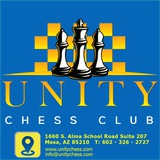The correct reaction was 11.Ne2 Nxe2+! 12.Qxe2 h4 13.Kh2 (13.g4 Nh7 14.c3 Qe7=) 13...Qd7 14.g4 Nh7 15.f4 Qe7 16.Qf3 Nf8, with an approximately equal game.
Helping Black develop play on the dark squares. More sensible was 12.Bd2 h4 13.g4, or 12.Be3, or even 12.Qd2 – after all of these choices, Black has a small advantage.
12.Qd2 Nxg5 13.Qxg5 h4!=/+.
12.Qd2 Nxg5 13.Qxg5 h4!=/+.
Black already has a significant advantage – one only needs to compare the bishops on g2 and c5.
13.Qf3 Qh6 14.Nd5 h4 15.Kh2 c6 16.b4 Bd4 17.c3 cxd5 18.cxd4 Nxd4 19.Qg4 hxg3+ 20.fxg3 0-0 21.Rac1 dxe4
Unity Chess Club
Konstantin Sakaev 2672 Vladimir Potkin 2552 Russia 2005 White to move
White has prepared a possible battery along the b1-h7 diagonal, for which he only needs one bishop move. Now is the time to start softening up the black defences:
Black’s pieces are mobilised, so he tries to find counterplay in the centre. If he allows h4-h5 and the subsequent opening of diagonals, the black knight will have to occupy the passive square f8, whilst 18...h5 would give the white knight an outpost on g5.
The knight occupies a blockading position, and is also taking part in the attack.
Black’s king is weak, so White could keep the queens on, without worrying about the exchange: 24.Qg3! Nd3 25.Rxd3! cxd3 26.Qxd3 Rf8 27.Nf3 – the attack on the light squares decides.
The most solid – the d5-pawn needs to be blockaded or destroyed and the passed e- and f-pawns should decide the game.
26...Rb8 27.Nxb3 cxb3 28.Be6+ Kf8 29.Bxd5 Bxd5 30.Nxd5 Rbc8 31.f4 Rc2 32.f5 Bxe5 33.Rxe5 Rxb2 34.Re3 b5 35.Kh2!
